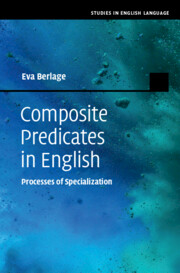Refine search
Actions for selected content:
6584 results in Grammar and Syntax
Chapter 1 - Introduction
-
- Book:
- Composite Predicates in English
- Published online:
- 09 May 2025
- Print publication:
- 15 May 2025, pp 1-17
-
- Chapter
- Export citation
Figures
-
- Book:
- Composite Predicates in English
- Published online:
- 09 May 2025
- Print publication:
- 15 May 2025, pp ix-ix
-
- Chapter
- Export citation
Chapter 3 - The CPs under investigation, the simple verbs and the hypotheses
-
- Book:
- Composite Predicates in English
- Published online:
- 09 May 2025
- Print publication:
- 15 May 2025, pp 27-39
-
- Chapter
- Export citation
Chapter 8 - The syntactic status of the CPs and a comparison of semantic and syntactic changes
-
- Book:
- Composite Predicates in English
- Published online:
- 09 May 2025
- Print publication:
- 15 May 2025, pp 158-172
-
- Chapter
- Export citation
References
-
- Book:
- Composite Predicates in English
- Published online:
- 09 May 2025
- Print publication:
- 15 May 2025, pp 203-215
-
- Chapter
- Export citation
Chapter 10 - Conclusion and outlook
-
- Book:
- Composite Predicates in English
- Published online:
- 09 May 2025
- Print publication:
- 15 May 2025, pp 193-202
-
- Chapter
- Export citation
Chapter 4 - Methodology
-
- Book:
- Composite Predicates in English
- Published online:
- 09 May 2025
- Print publication:
- 15 May 2025, pp 40-66
-
- Chapter
- Export citation
Chapter 2 - The evolution of CPs: Theories, concepts and their relevance
-
- Book:
- Composite Predicates in English
- Published online:
- 09 May 2025
- Print publication:
- 15 May 2025, pp 18-26
-
- Chapter
- Export citation
Index
-
- Book:
- Composite Predicates in English
- Published online:
- 09 May 2025
- Print publication:
- 15 May 2025, pp 216-218
-
- Chapter
- Export citation
Chapter 9 - Theoretical discussion
-
- Book:
- Composite Predicates in English
- Published online:
- 09 May 2025
- Print publication:
- 15 May 2025, pp 173-192
-
- Chapter
- Export citation
Chapter 6 - The semantic evolution of Type I-CPs
-
- Book:
- Composite Predicates in English
- Published online:
- 09 May 2025
- Print publication:
- 15 May 2025, pp 82-124
-
- Chapter
- Export citation
Copyright page
-
- Book:
- Composite Predicates in English
- Published online:
- 09 May 2025
- Print publication:
- 15 May 2025, pp vi-vi
-
- Chapter
- Export citation
Abbreviations and Symbols
-
- Book:
- Composite Predicates in English
- Published online:
- 09 May 2025
- Print publication:
- 15 May 2025, pp xviii-xviii
-
- Chapter
- Export citation
Contents
-
- Book:
- Composite Predicates in English
- Published online:
- 09 May 2025
- Print publication:
- 15 May 2025, pp vii-viii
-
- Chapter
- Export citation
Chapter 5 - The evolution of the simple verbs
-
- Book:
- Composite Predicates in English
- Published online:
- 09 May 2025
- Print publication:
- 15 May 2025, pp 67-81
-
- Chapter
- Export citation
Chapter 7 - The semantic evolution of Type II-CPs
-
- Book:
- Composite Predicates in English
- Published online:
- 09 May 2025
- Print publication:
- 15 May 2025, pp 125-157
-
- Chapter
- Export citation

Composite Predicates in English
- Processes of Specialization
-
- Published online:
- 09 May 2025
- Print publication:
- 15 May 2025
Introduction
-
- Book:
- The Parameter in Generative Grammar
- Published online:
- 17 April 2025
- Print publication:
- 24 April 2025, pp 1-2
-
- Chapter
- Export citation
5 - The Head-Complement Parameter
-
- Book:
- The Parameter in Generative Grammar
- Published online:
- 17 April 2025
- Print publication:
- 24 April 2025, pp 256-313
-
- Chapter
- Export citation
6 - Some Concluding Remarks on Parameterization
-
- Book:
- The Parameter in Generative Grammar
- Published online:
- 17 April 2025
- Print publication:
- 24 April 2025, pp 314-318
-
- Chapter
- Export citation
